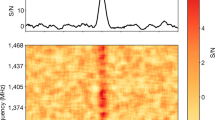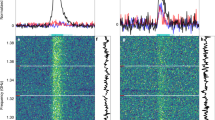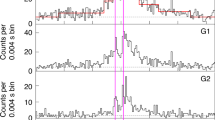Abstract
Fast radio bursts (FRBs) are millisecond-duration radio transients of unknown physical origin observed at extragalactic distances1,2,3. It has long been speculated that magnetars are the engine powering repeating bursts from FRB sources4,5,6,7,8,9,10,11,12,13, but no convincing evidence has been collected so far14. Recently, the Galactic magnetar SRG 1935+2154 entered an active phase by emitting intense soft γ-ray bursts15. One FRB-like event with two peaks (FRB 200428) and a luminosity slightly lower than the faintest extragalactic FRBs was detected from the source, in association with a soft γ-ray/hard-X-ray flare18,19,20,21. Here we report an eight-hour targeted radio observational campaign comprising four sessions and assisted by multi-wavelength (optical and hard-X-ray) data. During the third session, 29 soft-γ-ray repeater (SGR) bursts were detected in γ-ray energies. Throughout the observing period, we detected no single dispersed pulsed emission coincident with the arrivals of SGR bursts, but unfortunately we were not observing when the FRB was detected. The non-detection places a fluence upper limit that is eight orders of magnitude lower than the fluence of FRB 200428. Our results suggest that FRB–SGR burst associations are rare. FRBs may be highly relativistic and geometrically beamed, or FRB-like events associated with SGR bursts may have narrow spectra and characteristic frequencies outside the observed band. It is also possible that the physical conditions required to achieve coherent radiation in SGR bursts are difficult to satisfy, and that only under extreme conditions could an FRB be associated with an SGR burst.
This is a preview of subscription content, access via your institution
Access options
Access Nature and 54 other Nature Portfolio journals
Get Nature+, our best-value online-access subscription
$29.99 / 30 days
cancel any time
Subscribe to this journal
Receive 51 print issues and online access
$199.00 per year
only $3.90 per issue
Buy this article
- Purchase on Springer Link
- Instant access to full article PDF
Prices may be subject to local taxes which are calculated during checkout


Similar content being viewed by others
Data availability
Processed data are presented in the tables and figures within the paper. Source data are available from the corresponding authors upon reasonable request. The Fermi/GBM data are publicly available at https://heasarc.gsfc.nasa.gov/FTP/fermi/data/.
References
Lorimer, D. R., Bailes, M., McLaughlin, M. A., Narkevic, D. J. & Crawford, F. A bright millisecond radio burst of extragalactic origin. Science 318, 777–780 (2007).
Petroff, E., Hessels, J. W. T. & Lorimer, D. R. Fast radio bursts. Astron. Astrophys. Rev. 27, 4 (2019).
Cordes, J. M. & Chatterjee, S. Fast radio bursts: an extragalactic enigma. Annu. Rev. Astron. Astrophys. 57, 417–465 (2019).
Popov, S. B. & Postnov, K. A. Hyperflares of SGRs as an engine for millisecond extragalactic radio bursts. In Evolution of Cosmic Objects through their Physical Activity (eds Harutyunian, H. A. et al.) 129–132 (Gitutyun, 2010).
Kulkarni, S. R., Ofek, E. O., Neill, J. D., Zheng, Z. & Juric, M. Giant sparks at cosmological distances? Astrophys. J. 797, 70 (2014).
Murase, K., Kashiyama, K. & Mészáros, P. A burst in a wind bubble and the impact on baryonic ejecta: high-energy gamma-ray flashes and afterglows from fast radio bursts and pulsar-driven supernova remnants. Mon. Not. R. Astron. Soc. 461, 1498–1511 (2016).
Katz, J. I. How soft gamma repeaters might make fast radio bursts. Astrophys. J. 826, 226 (2016).
Metzger, B. D., Berger, E. & Margalit, B. Millisecond magnetar birth connects FRB 121102 to superluminous supernovae and long-duration gamma-ray bursts. Astrophys. J. 841, 14 (2017).
Beloborodov, A. M. A flaring magnetar in FRB 121102? Astrophys. J. Lett. 843, 26 (2017).
Kumar, P., Lu, W. & Bhattacharya, M. Fast radio burst source properties and curvature radiation model. Mon. Not. R. Astron. Soc. 468, 2726–2739 (2017).
Yang, Y.-P. & Zhang, B. Bunching coherent curvature radiation in three-dimensional magnetic field geometry: application to pulsars and fast radio bursts. Astrophys. J. 868, 31 (2018).
Wadiasingh, Z. et al. The fast radio burst luminosity function and death line in the low-twist magnetar model. Astrophys. J. 891, 82 (2020).
Cheng, Y., Zhang, G. Q. & Wang, F. Y. Statistical properties of magnetar bursts and FRB 121102. Mon. Not. R. Astron. Soc. 491, 1498–1505 (2020).
Sun, S., Yu, W., Yu, Y., Mao, D. & Lin, J. A search for short-term hard X-Ray bursts in the direction of the repeating FRB 121102. Astrophys. J. 885, 55 (2019).
Veres, P., Bissaldi, E., Briggs, M. S. & Fermi GBM Team SGR 1935+2154: Fermi GBM observation. GRB Coord. Netw. 27531, https://gcn.gsfc.nasa.gov/gcn3/27531.gcn3 (2020).
CHIME/FRB Collaboration. A bright millisecond-duration radio burst from a Galactic magnetar. Nature http://doi.org/10.1038/s41586-020-2863-y (2020).
Bochenek, C. D. et al. A fast radio burst associated with a Galactic magnetar. Nature http://doi.org/10.1038/s41586-020-2872-x (2020).
Li, C. K. et al. Identification of a non-thermal X-ray burst with the Galactic magnetar SGR 1935+2154 and a fast radio burst with Insight-HXMT. Preprint at https://arxiv.org/abs/2005.11071 (2020).
Mereghetti, S. et al. INTEGRAL discovery of a burst with associated radio emission from the magnetar SGR 1935+2154. Astrophys. J. Lett. 898, 29 (2020).
Tavani, M. et al. An X-ray burst from a magnetar enlightening the mechanism of fast radio bursts. Preprint at https://arxiv.org/abs/2005.12164 (2020).
Ridnaia, A. et al. A peculiar hard X-ray counterpart of a Galactic fast radio burst. Preprint at https://arxiv.org/abs/2005.11178 (2020).
Nan, R. et al. The five-hundred-meter aperture spherical radio telescope (FAST) project. Int. J. Mod. Phys. D 20, 989–1024 (2011).
Collazzi, A. C. et al. The five year Fermi/GBM magnetar burst catalog. Astrophys. J. 218, 11 (2015).
Lin, L. et al. Burst properties of the most recurring transient magnetar SGR J1935+2154. Astrophys. J. 893, 156 (2020); erratum 898, 176 (2020).
Lu, W. & Kumar, P. On the radiation mechanism of repeating fast radio bursts. Mon. Not. R. Astron. Soc. 477, 2470–2493 (2018).
Lyubarsky, Y. A model for fast extragalactic radio bursts. Mon. Not. R. Astron. Soc. 442, L9–L13 (2014).
Waxman, E. On the origin of fast radio bursts (FRBs). Astrophys. J. 842, 34 (2017).
Metzger, B. D., Margalit, B. & Sironi, L. Fast radio bursts as synchrotron maser emission from decelerating relativistic blast waves. Mon. Not. R. Astron. Soc. 485, 4091–4106 (2019).
Beloborodov, A. M. Blast waves from magnetar flares and fast radio bursts. Astrophys. J. 896, 142 (2020).
Yang, Y.-P., Zhang, B. & Wei, J.-Y. How bright are fast optical bursts associated with fast radio bursts? Astrophys. J. 878, 89 (2019).
Men, Y. P. et al. Piggyback search for fast radio bursts using Nanshan 26 m and Kunming 40 m radio telescopes—I. Observing and data analysis systems, discovery of a mysterious peryton. Mon. Not. R. Astron. Soc. 488, 3957–3971 (2019).
Jiang, P. et al. The fundamental performance of FAST with 19-beam receiver at L band. Res. Astron. Astrophys. 20, 064 (2020).
Israel, G. L. et al. The discovery, monitoring and environment of SGR J1935+2154. Mon. Not. R. Astron. Soc. 457, 3448–3456 (2016).
Zhang, S.-N. et al. Overview to the Hard X-ray Modulation Telescope (Insight-HXMT) Satellite. Sci. China Phys. Mech. Astron. 63, 249502 (2020).
Fletcher, C. & Fermi GBM Team Fermi GBM observation of a bright flare from magnetar SGR 1935+2154. GRB Coord. Netw. 27659, https://gcn.gsfc.nasa.gov/gcn3/27659.gcn3 (2020).
Li, C. K. et al. Updated catalog of X-ray bursts of SGR J1935+2154 from Insight-HXMT observations. GRB Coord. Netw. 28027, https://gcn.gsfc.nasa.gov/gcn3/28027.gcn3 (2020).
Palmer, D. M. A forest of bursts from SGR 1935+2154. Astron. Telegr. 13675 http://www.astronomerstelegram.org/?read=13675 (2020).
Tohuvavohu, A. SGR 1935+2154: a complete catalog of X-ray burst times from Swift/BAT imaging. Astron. Telegr. 13758, http://www.astronomerstelegram.org/?read=13758 (2020).
Borghese, A. et al. The X-ray reactivation of the radio bursting magnetar SGR 1935+2154. Preprint at https://arxiv.org/abs/2006.00215 (2020).
Younes, G. et al. A possible polar origin for the FRB associated with a Galactic magnetar. Preprint at https://arxiv.org/abs/2006.11358 (2020).
Marathe, A. et al. SGR 1935+2154: AstroSat CZTI detections. GRB Coord. Netw. 27664, https://gcn.gsfc.nasa.gov/gcn3/27664.gcn3 (2020).
Cherry, M. L. et al. Bright SGR burst detected by CALET Gamma-Ray Burst Monitor. GRB Coord. Netw. 27623, https://gcn.gsfc.nasa.gov/gcn/gcn3/27623.gcn3 (2020).
Castro-Tirado, A. J. et al. Building the BOOTES world-wide network of robotic telescopes. In Astronomical Society of India Conference Series Vol. 7, 313–320 (Astronomical Society of India, 2012).
Zhou, P. et al. Revisiting the distance, environment and supernova properties of SNR G57.2+0.8 that hosts SGR 1935+2154. Preprint at https://arxiv.org/abs/2005.03517 (2020).
Kothes, R., Sun, X., Gaensler, B. & Reich, W. A radio continuum and polarization study of SNR G57.2+0.8 associated with magnetar SGR 1935+2154. Astrophys. J. 852, 54 (2018).
Yüksel, H., Kistler, M. D., Beacom, J. F. & Hopkins, A. M. Revealing the high-redshift star formation rate with gamma-ray bursts. Astrophys. J. Lett. 683, 5 (2008).
Planck Collaboration. Planck 2015 results. XIII. Cosmological parameters. Astron. Astrophys. 594, A13 (2016).
Salpeter, E. E. The luminosity function and stellar evolution. Astrophys. J. 121, 161–167 (1955).
CHIME/FRB Collaboration. The CHIME fast radio burst project: system overview. Astrophys. J. 863, 48 (2018).
Luo, R. et al. On the FRB luminosity function—II. Event rate density. Mon. Not. R. Astron. Soc. 494, 665–679 (2020).
Acknowledgements
This work is supported by the Natural Science Foundation of China (grants 11988101, 11673002, 11703002, 11543004, 11722324, 11690024, 11633001, 11920101003, 11833003, 11722324, 11633001, 11690024, 11573014, 11725314, 11690024, 11743002, 11873067, 11533003, 11673006, U1938201, 11725313, 11721303, 1172130, U15311243, U1831207, U1838201, U1838202, U1838113, U1938109), National Key Research and Development Programs of China (grants 2018YFA0404204, 2017YFA0402600), the Program for Innovative Talents and Entrepreneur in Jiangsu, the KIAA-CAS Fellowship, the China Postdoctoral Science Foundation (grants 2018M631242, 2016YFA0400800, 2018YFA0400802, E01S11BQ10, XDB23010200,XDB2304040, QYZDY-SSW-SLH008), the International Partnership Program of Chinese Academy of Sciences (grant number 114A11KYSB20160008), the Cultivation Project for FAST Scientific Payoff and Research Achievement of CAMS-CAS, the Max-Planck Partner Group, the Spanish Science Ministry “Centro de Excelencia Severo Ochoa” Program (grant SEV-2017-0709), the Junta de Andalucía (Project P07-TIC-03094) and the Spanish Ministry Projects AYA2012-39727-C03-01, AYA2015-71718R and PID2019-109974RB-I00. We thank E. Fernández-García (IAA-CSIC), I. M. Carrasco-García and C. Pérez del Pulgar (UMA) and the rest of the BOOTES Team for making the reported BOOTES Network observations possible. This work made use of data from FAST—a Chinese national mega-science facility, built and operated by the National Astronomical Observatories, Chinese Academy of Sciences. We also acknowledge the use of public data from the Fermi Science Support Center (FSSC).
Author information
Authors and Affiliations
Contributions
L.L., B.Z. and D.L. launched the FAST observational campaign on SGR 1935+2154. C.F.Z. and P.W. systematically processed the FAST data independently and cross-compared the results. K.J.L. and D.L. coordinated the FAST data analysis campaign; J.L.H., Y.P.M., C.C.M., C.H.N., J.R.N., B.J.W., H.X., J.L.X., W.Y., D.J.Z. and W.W.Z. participated in the FAST data analysis. X.G., P.J., C.S. and Z.L.W. coordinated the FAST observations. B.B.Z., L.L., Y.H.Y., L.S., Y.S.Y., J.H.Z., F.Y.W. and G.Q.Z. processed the Fermi/GBM data. L.L., S.N.Z., M.Y.G., S.M.J., C.K.L. and S.L.X. performed joint Insight-HXMT observations with FAST and processed the data. B.B.Z., A.J.C.-T., Y.D.H. and R.Q. carried out the BOOTES optical observations. X.G.W., E.W.L. and T.C.Z. carried out the LCOGT optical observations. B.Z. coordinated the science team. H.G., Y.P.Y., Z.G.D., Y.L., Z.L., F.Y.W., X.F.W. and R.X.X. contributed to theoretical investigations of the physical implications of the observational results. B.Z., K.J.L., B.B.Z., Y.P.Y., H.G., L.L., C.F.Z., Y.L. and J.L.H. contributed to the writing of the paper.
Corresponding authors
Ethics declarations
Competing interests
The authors declare no competing interests.
Additional information
Peer review information Nature thanks Amanda Weltman for her contribution to the peer review of this work. Peer reviewer reports are available.
Publisher’s note Springer Nature remains neutral with regard to jurisdictional claims in published maps and institutional affiliations.
Extended data figures and tables
Extended Data Fig. 1 Flux and fluence upper limits from FAST observation.
a, b, The horizontal axis shows the pulse width, and the vertical axes show the flux (a) and fluence (b) upper limits.
Extended Data Fig. 2 FRB radio candidates around the epochs of all 29 Fermi/GBM bursts.
As in Fig. 2, except that the observations are centred around the epochs of different GBM bursts.
Extended Data Fig. 3 T90 and fluence distribution of 29 Fermi/GBM bursts with best-fitting lines.
a, Distribution of the duration T90. b, Fluence distribution. The error bars are defined as the square root of the burst number in each fluence bin.
Extended Data Fig. 4 Jet beaming angle constraints.
a, Relationship between jet beaming angle θj and Lorentz factor Γ constrained by the observed probability; see equation (7). b, Constrained probability (P) contours in the θj−Γ plane. The colour scale is logarithmic, that is, logP.
Extended Data Fig. 5 Spectra and spectral peak distribution constraints.
a, Relationship between mean peak frequency \({\bar{\nu }}_{{\rm{peak}}}\) and spectrum width Δν constrained by the observed probability. The dashed line corresponds to Δν = 0.4 GHz. b, Constrained probability (P) contours in the \({\bar{\nu }}_{{\rm{peak}}}\)–\(\Delta \nu \) plane. The colour scale is logarithmic, that is, logP.
Supplementary information
Rights and permissions
About this article
Cite this article
Lin, L., Zhang, C.F., Wang, P. et al. No pulsed radio emission during a bursting phase of a Galactic magnetar. Nature 587, 63–65 (2020). https://doi.org/10.1038/s41586-020-2839-y
Received:
Accepted:
Published:
Issue Date:
DOI: https://doi.org/10.1038/s41586-020-2839-y
This article is cited by
-
Quasi-periodic sub-pulse structure as a unifying feature for radio-emitting neutron stars
Nature Astronomy (2023)
-
Magnetar spin-down glitch clearing the way for FRB-like bursts and a pulsed radio episode
Nature Astronomy (2023)
-
In-orbit performance of ME onboard Insight-HXMT in the first 5 years
Radiation Detection Technology and Methods (2023)
-
Pose optimization of the FAST feed support system based on the new feed cabin mechanism
Science China Physics, Mechanics & Astronomy (2023)
-
Cosmology with fast radio bursts in the era of SKA
Science China Physics, Mechanics & Astronomy (2023)
Comments
By submitting a comment you agree to abide by our Terms and Community Guidelines. If you find something abusive or that does not comply with our terms or guidelines please flag it as inappropriate.



